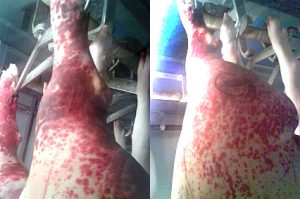Porcine dermatitis and nephropathy syndrome (PDNS).
In three hybrid breed pigs, of approximately 6 months of age, erythematous lesions were observed in the skin of the hind limbs, and in one case, enlargement and hemorrhages of the kidneys. These lesions suggested a diagnosis of Porcine dermatitis and nephropathy syndrome . Meat inspectors asked whether the carcass should be considered suitable or not for human consumption due to a possible uremia.
The images submitted are indeed compatible with Porcine dermatitis and nephropathy syndrome (PDNS), therefore animals have a systemic inflammatory lesion (systemic necrotizing vasculitis) which affects the entire carcass.
Regulations stipulate that carcasses and offal of an animal with a generalized disease must be condemned.
This syndrome has been associated with type III hypersensitivity and has been associated with the porcine circovirus type 2 (PCV2), the reproductive and respiratory syndrome virus (PRRSV) and with Pasteurella multocida. Currently PDNS is considered a disease associated with PCV2 infection.
In cases where renal lesions are observed the presence of uremia can not be excluded. To confirm it, the levels of creatinine and urea in blood or fluid from the anterior chamber of the eye can be checked (with a urine strip) .


